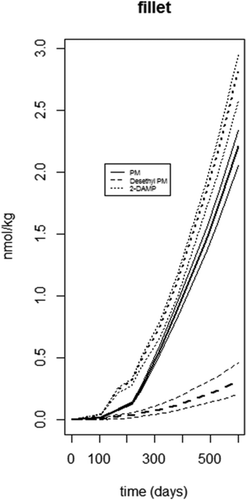Figures & data
Figure 1. Two-compartment PBPK model for the disposition of dietary pirimiphos-methyl (PM) and metabolites (2-DAMP and Desethyl-PM) in the central (including white muscle fibres) and fat compartments of Atlantic salmon after exposure to a mixture of these compounds. See main text for definition of symbols
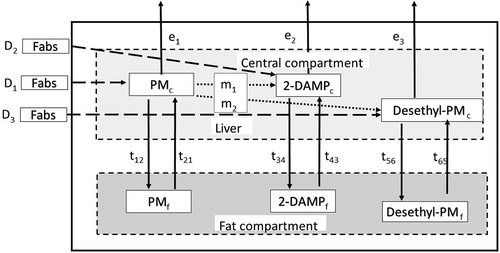
Figure 2. a-d) Concentration (nmol kg−1 ww) of the pesticide pirimiphos-methyl (PM) and its two main metabolites Desethyl-PM and 2-DAMP in fillet (a), kidney (b), liver (c) and bile (d) of Atlantic salmon (Salmo salar) fed PM spiked feeds (5.1 mg kg−1) for 81 days. Columns are the mean values and standard deviation (n = 9, mean ± SD). Columns with different superscripts are significantly different (p < .05, ANOVA, Tukey’s HSD t-test) from each other
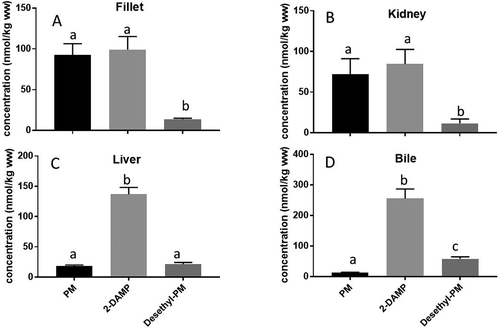
Figure 3. (a-c) Total amounts (in nmol) of PM (a) and the two metabolites (Desethyl-PM and 2-DAMP, b and c, respectively)) in the fillet of Atlantic salmon (Salmo salar) fed PM enriched feeds (5.1 mg kg−1) for 81 days followed by a 39-day elimination period (values are n = 3, mean ± SD). Vertical line indicates change from exposure into elimination period
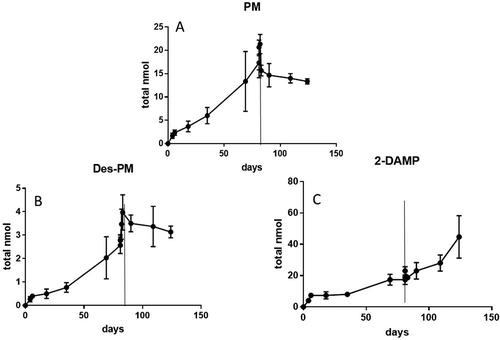
Figure 4. (a-c) Total amounts (in nmol) of PM (a) and the two metabolites (Desethyl-PM and 2-DAMP, b and c, respectively) in adipose tissue (fat) in Atlantic salmon (Salmo salar) fed PM enriched feeds (5.1 mg kg−1) for 81 days followed by a 39-day elimination period (values are n = 3, mean ± SD). Vertical line indicates change from exposure into elimination period
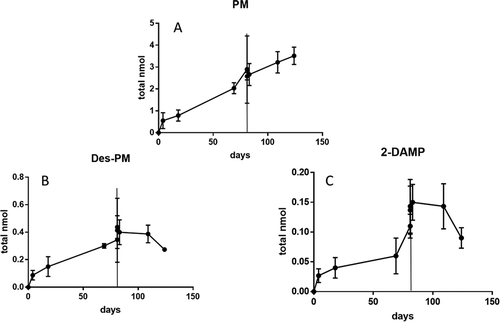
Figure 5. Model predicted fillet total level (nmol) (even line) and experimental data (three broken lines for the three different experimental tanks) for PM and the two metabolites (2-DAMP and Desethyl-PM) in the fillet and adipose tissue (fat) Atlantic salmon fed PM enriched feeds (5.1 mg kg−1) in triplicate tanks for 81 days followed by a 39-day depuration period
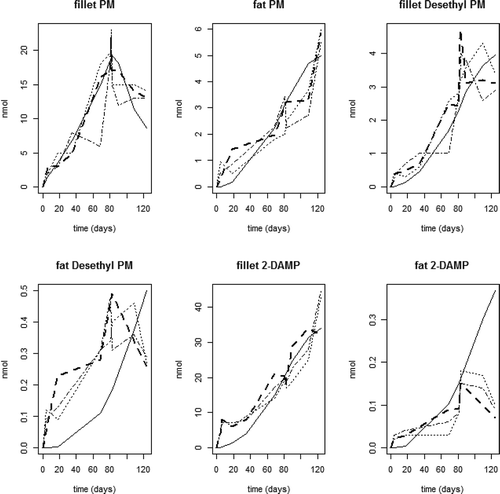
Figure 6. Whole seawater production cycle model predictions of fillet PM and its two metabolites 2-DAMP and N-Desethyl-PM concentrations (nmol kg−1 ww) in Atlantic salmon fed highest (0.019 mg kg−1) PM background levels surveyed in Norwegian commercial salmon feeds in 2018. Solid line is PM, dashed line is Desethyl-PM, dotted line is 2-DAMP. Thicker line in the middle is the mean and thinner lines are 95% lower and upper bounds
